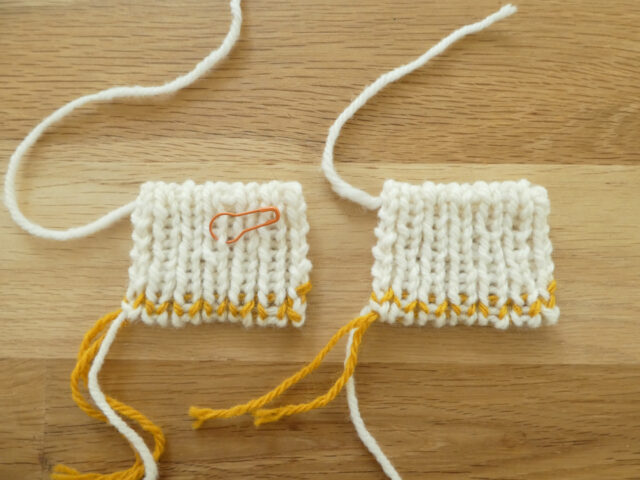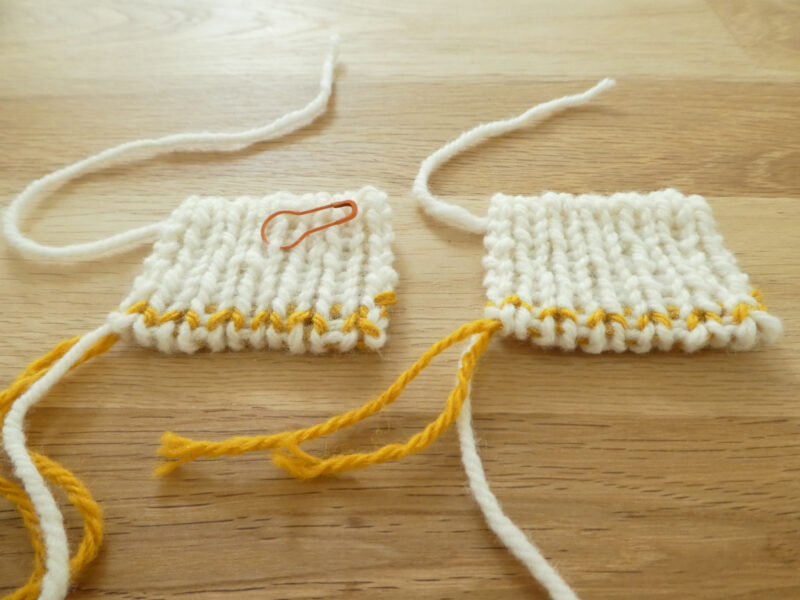Yes, I’m finally back to this series about the tubular cast-on (I have to admit that I forgot about this series lol)!
So the first thing among the lot of things to say is about a little note I inserted at the beginning of the first tutorial in the last post.
When you finish casting on stitches with a KNIT stitch, many handbooks tell you, for the first set-up rows of a project worked back and forth, to knit the knit stitches and slip the purl stitches with yarn in front. I recommend the contrary in my tutorial for this case and tell you to purl the purls and slip the knits with yarn in back, and you may have wondered why.
I have to say honestly that Italian tubular cast-on is not easy and I don’t use (nor like) it much though I made a tutorial 😆 The very difficulty of this method for me is at the end of casting on stitches. The last cast-on stitch, whether it is a knit stitch or a purl stitch, is indeed just a loop on the needle and is incomplete, and it can be lost if you don’t pay attention. Some books say to twist the tail and working yarn but I found that not so sure (it can be untwisted when you turn your work or join stitches into the round). So to move on to the next step serenely, I tied a knot to secure it. The stitch is now complete (you have a purl bump for a purl stitch or a complete loop on the needle for a knit st) and to secure it more, I immediately worked the stitch, which is a purl because we have finished the CO row with a knit stitch.
You may already know that on a right side tubular set-up row, you knit the knits and slip the purls with yarn in front. And if you do this on a wrong side row, you should purl the purls and slip the knits with yarn in back. So basically, I just reversed what we do in the wrong and right side rows, to secure that last cast-on stitch. It sounds I’m obsessed with it 😆 but in this way, we are not bothered by it!
To be sure that this gives the same result, I knitted the samples. I used a different color for the set-up rows.

The one was worked with “p1, sl1 wyib” and the other with “k1, sl1 wyif”, and I don’t know which is which anymore.
There is indeed a very slight difference: on the left sample, the cast-on tail is below the yellow yarn and on the right sample the tail is over the yellow yarn. But the overall impression is the same, isn’t it? (who on earth would come and look at your tubular cast-on edge and tell you that you inversed the set-up rows, huh?)
I followed the same logic to the end: the last cast-on stitch should be secured! So when it is a purl stitch, you start the set-up row with a knit stitch. So I knit this first stitch and slip the purls, as directed in knitting handbooks. This is in the tutorial 2-2.
Joining cast on stitches directly in the round is much harder because it’s hard to see if the stitches are twisted with this cast-on. Some patterns could tell you to work set-up rows back and forth though the sweater is worked in the round. The part 2-2 is for those patterns.
But if you love challenge, you can directly join stitches in the round. And in this case, you secure the last cast-on stitch by knitting the first stitch of the set-up round. And on the second round, you work the contrary (purl 1, slip 1 with yarn in back), as in 2-1 🙂
In all of the tutorials, I recommend you leave the knot because I found it almost invisible but you can of course untie it if you wish.
The next post should be about how to transform this cast-on for 1×1 ribbing into 2×2 ribbing.
Do you find this post helpful? Please consider supporting me if you want to read more helpful posts. Thank you 💜
![]()

